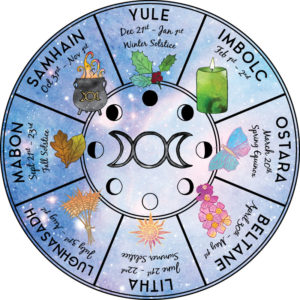The wheel of the year forms the basis of the Wiccan calendar.

As Wicca does not have a central holy text or designated place of worship, all of these details are left up to the individual traditions, covens, and solitary practitioners to decide on for themselves.
Despite this flexibility, the wheel of the year is considered the structural center for the religion.
The eight holidays of the wiccan year, also known as the Sabbats, provide regular occasions for practitioners to come together, whether it’s for coven rituals or more informal circle celebrations.
This divine pair is responsible for all creation in Nature, and each has a crucial roles to play in the cycles of plant and animal life during the course of the year. As the God represents the Sun, and the Goddess the Earth, their relationship is seen in two ways: as mother and child, and as procreating lovers.
In this way, both the presence and absence of warmth and sunlight over the course of the seasons
is explained: the God is born, grows up and reaches the height of his power, and then ages and dies, to be born again as the growth cycle is renewed.
The Goddess, who is Earth, is both mother and co-creative partner to God, remaining steadfast and present throughout the year, even in the absence of warmth and light. She is the constant, which may be why her Sabbats – the Earth festivals are considered to have greater power.The overall vision of the endless birth/death/rebirth cycle is one balance between the female and male universal energies and each
Sabbat can be seen as representing a particular stage of the cycle.
Important note: because the equinoxes and solstices happen at precise moments in time, they may fall on different dates in different parts of the world, and the
date can vary from one year to the next. Therefore, a range of possible dates is given for the solar Sabbats.
Wicca Living (2019). The wheel of the year: Wiccan sabbats. Retrieved from http://wiccaliving.com/wheel-of-the-year-wiccan-sabbats/